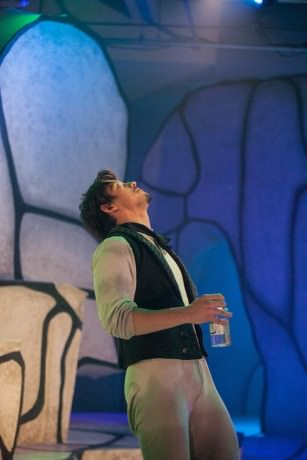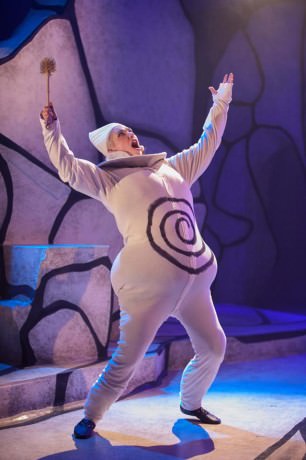The author of the infamous Ubu Roi, the play which proudly proclaims high culture as but “pshit” sculpted into attractive façades, Alfred Jarry is now the subject of a new script playing at Spooky Action Theater.

Freely adapted from the life and work of Alfred Jarry by Spooky Action Artistic Director Richard Henrich, the script is a hodgepodge of historical and fictional events and scripts and diatribes that swept over symbolist Paris, circa 1900.
Although the production offers much in the way of a primer on Jarry’s life and work, its overall effect suffers from stylistic diffusion and structural incoherence.
At times looking very much like a bio-play, with scenes ripped right from the headlines of Parisian gossip columnists, while at other times taking scenes from Jarry’s scripts, the combination leaves the viewer with that meandering sense and sensibility.
Henrich’s Jarry, played by the energetic and engaging Ryan Sellers, does not materialize as the culture busting, Academy-challenging, rule-breaking protagonist that you might imagine him to be.
Oh, what a difference 110 years make.

When Jarry’s poet predecessor, the 16-year old Arthur Rimbaud, burst onto the Symbolists poetry world via Paul Valéry in 1870, he set the Paris cultural scene aflame.
Proclaiming, “I’m now making myself as scummy as I can. Why? I want to be a poet, and I’m working at turning myself into a seer,” Rimbaud began the tradition of young French school boys challenging their artistic elders by re-inventing the cultural landscape. If art was to advance and explore new territory, then as with Charles Baudelaire’s Fleurs du mal (Flowers of Evil), the artist must be willing to plunge headfirst into life, however decadent, repugnant, or socially distasteful that life might be.
Unfortunately, many of the societal rules that Rimbaud, and later Jarry, challenged are broken openly and en mass in today’s culture of excess.
Whether we are discussing Jarry’s sexual puckishness or his alcohol-smothered brain, well I’m sorry to say that sexual exploration or the consumption of mind-altering, mind-destroying substances in 2015 far exceed Jarry’s timid abuses.
So Henrich’s challenge was to invent a Jarry for the 21st century that might still arouse an inspirational flame and not just poor comparisons to a beach-week jamboree.
The production, directed by Catherine Tripp, works best when the performers are having the most fun, and Ubu still thrusts the largest tongue in one’s cheek. For Ubu is silliest most of all.
Ian LeValley takes on several roles, from a scum-eating character in Ubu to the Jarry-worshipping Dr. Saltas, who wants more than anything to collaborate with Jarry on a play about Pope Joan. LeValley brings vibrant life to all his characters.
Other strong performances are turned in by Karin Rosnizeck as The Old Lady, though “old” is not the word you’ll think of for her or her character; Mikey Cafarelli as the always flamboyant Oscar Wilde; and Carla Briscoe as the demure Rachilde, arts publisher and sexy rapscallion.
Eva Wilhelm, Connor J. Hogan, and Claire Anieta round out the cast in a variety of parts, from Hogan’s turn as the aloof Yeats, to Aneita’s odd combination as the alluring Manette and the hilarious Ubu, to Wilhelm’s Charlotte, Jarry’s sister caring for her dying brother, in what had to be the most grounded scene of the evening.
Set Designer Giorgos Tsappas sculpted a surrealistic landscape of irregular objects, which might have been not so surrealistic at all if, in fact, we really were inside Jarry’s ether-addled brain. Brian S. Allard added the lights, and the visual delights dazzle under the color.
Designer Erik Reagan Teague provided the costumes, a combination of the grotesquely Ubu with the strangely domestic long john, and all done in poor theatre style.
Hats are off to puppet designer Matthew McGee: his Genghis Khan and Marco Polo were fantastic as was the leg devouring spring with its lady of a thousand looks.
Near the end of Jarry Inside Out our protagonist — no longer Alfred, but now subsumed totally by his own invention, Ubu the King (an ironic twist of fate since the buffoonish Ubu first arose in Jarry’s adolescent mind as a caricature of one of his overweight ugly science teachers) — proclaims that “He believes that the brain, in decomposition, works beyond death and that it is his dreams that are Paradise.”
And he wants with all his physic to step into paradise (his dreams) as he dies.
Such a notion lies at the root of Jarry’s “pataphysics,” and such a notion would truly have been worth a theatrical exploration.
As it now stands, Jarry Inside Out gives us a taste of Jarry’s vision, but only a taste; the full meal is yet to come.
Running Time: 2 hours and 10 minutes, with an intermission.





